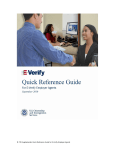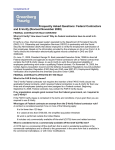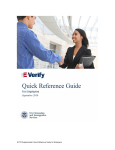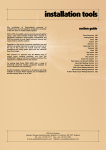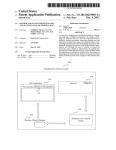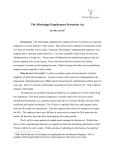Download Navigating Legal Landmines in the Battle Over
Transcript
ORANGE COUNTY BUSINESS JOURNAL $1.50 VOL. 38 NO. 10 www.ocbj.com Page 1 MARCH 9-15, 2015 Employers Beware: Navigating Legal Landmines in the Battle Over Immigration by James L. Morris, Partner, and Peter Hering, Associate, Rutan & Tucker n February 17, 2015, a Texas federal judge issued a preliminary injunction against President Obama’s executive immigration program granting temporary legal status to millions of undocumented immigrants. The Obama administration has appealed this ruling. Congress, meanwhile, is brawling bitterly over the program’s funding. While the battle rages at the federal level, the California legislature continues to pass laws affecting undocumented workers. Three recently-enacted laws in particular will have a significant impact on California employers. We briefly discuss California’s new laws and then examine two challenging scenarios California employers may well face. O New Laws: Strengthening Protections for Undocumented Workers A common thread runs through the new laws: they are designed to protect immigrant workers. 1. Don’t Discriminate Against Holders of California’s New Driver’s License Under a law passed in 2013 (AB60), the DMV has begun issuing driver’s licenses to drivers who are ineligible for a social security card and cannot prove their lawful presence in the United States (“AB60 Licenses”). Many who apply for this license are undocumented immigrants. As of January 1, 2015, California employers are prohibited from discriminating against any job applicant or employee who presents an AB60 License to the employer. Employers are also prohibited from asking for a driver’s license unless a license is a legal job requirement or a legitimate employer requirement. 2. Don’t Take Adverse Action Against Employees for Changing Their Name, Social Security Number, or Employment Authorization Documents The California legislature also amended a one-year old provision of the Labor Code, Section 1024.6, which prohibits taking any adverse employment action against an employee who “updates or attempts to update his or her personal information.” Until the 2014 amendment, the statute did not define “personal information,” thus creating uncertainty. Section 1024.6 now protects employees who update or attempt to update their personal information “based on a lawful change of Reprinted with the permission of the Orange County Business Journal name, social security number, or federal employment authorization document.” This change makes clear the intention of the statute: to protect undocumented workers who come forward and disclose their real identities. 3. Broadened Definition of Unfair Immigration-Related Practices Finally, the legislature broadened the definition of “unfair immigration-related practices” under Labor Code §1019. Section 1019 prohibits retaliation, through the use of such practices, against employees for exercising any rights under the Labor Code or local ordinances. The following actions are now prohibited: continued on page 2 James L. Morris Jim is the Chair of the Employment and Labor Section of Rutan & Tucker, where he represents employers in a wide variety of litigation and non-litigation matters. He has been selected repeatedly for inclusion in the prestigious publication Best Lawyers in America in labor and employment categories. He has also been chosen for many years as a Southern California “Super Lawyer” for employment and labor law. In July 2014, he was selected as one of California’s top 75 labor & employment lawyers by the Daily Journal legal newspaper. Jim can be reached at 714.641.3483 or [email protected]. Peter Hering Peter is an associate in the firm’s Employment and Labor Section, where he handles a variety of employment-related litigation and non-litigation matters, including wage and hour, employment discrimination, harassment, and wrongful discharge claims. Peter can be reached at 714.338.1804 or [email protected]. ORANGE COUNTY BUSINESS JOURNAL $1.50 VOL. 38 NO. 10 www.ocbj.com u Requesting more or different documentation than required under federal law (8 U.S.C. §1324a(b)); u Using E-Verify at a time or in a manner not required by Section 1324a(b), or authorized by the E-Verify memorandum of understanding (the “E-Verify MOU”); u Threatening to file or filing a false police report or false report or complaint with any state or federal agency; u Threatening to contact or contacting immigration authorities. Two Likely Scenarios and Their Risks for Employers Employers now find themselves between a rock and a hard place. On one hand, federal law makes it illegal to hire workers who the employer knows, or has reason to know, lack legal authorization. On the other hand, California law prohibits taking adverse action against workers who, by their actions, put the employer on notice about past or present problems with their employment authorization. Scenario 1: An Existing Employee Approaches You to Update Her Social Security Number An employee approaches you and asks to change her social security number. Since a person can have only one social security number, the employee effectively has just told you she has been using a false social security number. Because this dishonesty violates your corporate honesty policy, can you now terminate the employee? The new California answer is “no.” The employee is apparently exercising her right under Section 1024.6 to change her social security number. So, what should you do? First, you must update the employee’s I-9 information. The I-9 Handbook provides guidance on what to do in this situation: (1) ask the employee to complete a new Form I-9; (2) attach the new Form I-9 to the previous Form I-9; (3) in the employer section of the new Form I-9, list the original hire date; and (4) attach a written explanation documenting the change. Second, if you use E-Verify, you must carefully consider whether to run the updated information through E-Verify. As explained above, using E-Verify when it is not required by federal law or authorized by the E-Verify MOU is considered an unfair immigration-related practice. A close look at the relevant statute and the E-Verify MOU should caution against using E-Verify to check the updated information. Here’s why: u Section 1324a(b) does not require the use of E-Verify in this context. u The E-Verify MOU authorizes using E-Verify to verify employment eligibility only within 3 days of a new hire. Further, it prohibits E-Verify use unless specifically authorized by the E-Verify MOU or User Manual. u The E-Verify User Manual specifically prohibits the use of EVerify to re-verify the employment authorization of an existing employee. Seems clear enough so far, right? The I-9 Handbook, however, complicates your decision. It recommends that you “should verify the new Form I-9 information through E-Verify” when an employee has presented a new identity (e.g., new social security number). Reprinted with the permission of the Orange County Business Journal Page 2 MARCH 9-15, 2015 Given this contradictory guidance, the choice whether to use EVerify exposes you to potential liability either way. On the federal level, USCIS might take the position expressed in its I-9 Handbook and find that you failed properly to verify an employee’s work authorization by not using E-Verify. On the state level, you could face liability for engaging in unfair immigration-related practices by using E-Verify. Scenario 2: A New Employee Presents California’s New AB60 License During the I-9 Process A job applicant has presented two documents during the I-9 process: (1) an AB60 license to prove identity; and (2) a facially valid document establishing employment authorization (e.g., a social security card). Being familiar with the AB60 license, you know that to get this license, the job applicant had to certify ineligibility for a social security number and inability to prove lawful presence. Given this irreconcilable contradiction between the two documents, you reasonably suspect the applicant is not actually authorized to work. What should you do? As explained above, you cannot discriminate against the applicant simply because he presented an AB60 license. Further, asking for additional documents could be considered an unfair immigration-related practice under Labor Code §1019. Yet, if it turns out the applicant indeed was not authorized to work, you apparently would have hired an unauthorized worker when you were (quite logically) on notice about the employee’s lack of work authorization, thus violating federal law. In this situation, using E-Verify provides a distinct advantage, because you can satisfy your obligations by simply verifying the applicant’s identity through the system. If E-Verify raises no red flags, you can feel reasonably comfortable in hiring the applicant. (Note, however, that E-Verify cannot be expected to detect a fullystolen identity!) If you do not use E-Verify, the better part of discretion – however grating – may be to accept the documents the applicant presented, especially if the work authorization document appears valid. Conclusion: Difficult Choices The legal and policy tensions inherent in California and federal immigration-related laws make it hard to quantify an employer’s exact risks. Changes in the political climate in future years could always alter the calculus further. At a minimum, employers should follow a consistent approach, to avoid the appearance of singling out any employee. Federal immigration law violations include potential exposure to criminal charges, although such charges usually extend only to the “worst of the worst” offenders. At the state level, a draconian sanction has gone largely unnoticed: Potential suspension of an employer’s business licenses! That sanction, of course, effectively would put an employer out of business (at least temporarily), and would put all employees’ pay – and employment – at risk. You should carefully review California’s new immigrationrelated employment laws and how they may impact your business. To minimize your risks, consider doing two things: (1) train your human resources employees on how to handle these situations; and (2) identify whom to call when you face a unique situation.


